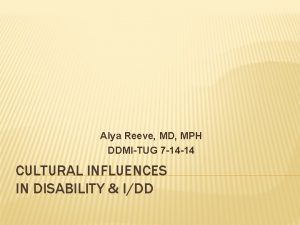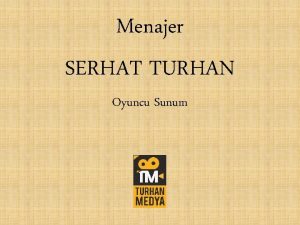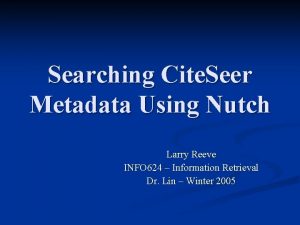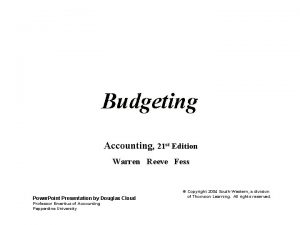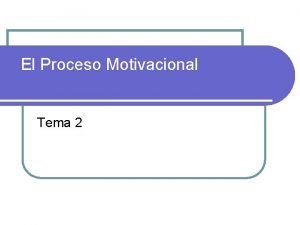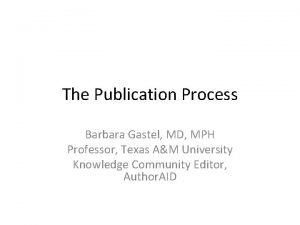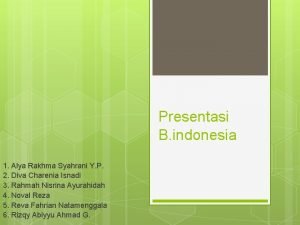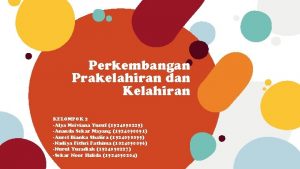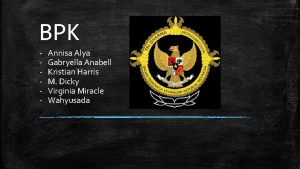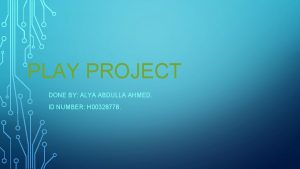Alya Reeve MD MPH DDMITUG 7 14 14













- Slides: 13

Alya Reeve, MD, MPH DDMI-TUG 7 -14 -14 CULTURAL INFLUENCES IN DISABILITY & I/DD

WHAT IS CULTURE? � Culture can be defined as the ways people live with each other, differentiating themselves from other groups of people. Culture reflects an integrated system of learned behavior patterns characteristic of a society that are not a result of biological inheritance. � It is often expressed by customary beliefs and social forms of a group. � � Can you cite examples of culture? . . .

WE ARE INFLUENCED BY CULTURE(S) All people are affected by and reflect their culture. � Attitudes about I/DD differ in Hispanic, Native-American, African-American, Mid. Eastern, Asian, and European cultural groups in the US. � Disabilities can create their own subcultures. � Cultural differences affect attitudes toward disability and even acceptance of services �

CULTURES WITHIN CULTURES � Habits and attitudes are learned as part of socialization. � Attitudes affect expectations of and opportunities provided to people with I/DD. � Assessment of adaptive behavior functioning needs must take into account some biases of current assessment tools.

CULTURAL ASSUMPTIONS � People with disability all have low IQ � If people do not talk, they do not understand � Sensory problems often form subcultures, with short-hands of communication and self-identification � Religious and regional variations

FACTORS AFFECTING BEHAVIOR � � � Attitudes toward Disability Family Structure Urban – Rural Family Training & Disciplinary Practices Gender Inclusion – Protection � � � SES & Education Communication Styles Acculturation Mental Health Issues Language Barriers Religion

ASSESSMENT OF ADAPTIVE BEHAVIOR � Informant Selection � Cultural Communication Styles � Informant Interviews � Evaluation of Opportunity vs. Ability � Norm-based Assessment vs. Service Planning Information

ADAPTIVE BEHAVIOR ASSESSMENT � Adaptive behavior expectations: The training in how to apply existing assessment tools needs to include specific attention to influences of culture on opportunities and missed opportunities for people with I/DD and other disabilities. � The biases of current assessment tools have to be part of the developing awareness in using these tools and the push to develop more appropriate and attuned tools in the future. �

IMPORTANCE � Inclusion � Interpretation of attitude � Professionals � Clients � Adaptation of tests � Making sure real problems are identified � Strengths be properly assessed and supported

INCREASE AWARENESS � Discussions For teams concerning challenging situations � Guardians, teachers, other professionals � � Case-sharing Clinical review; � Mentoring; � Supervision; � Training �

INCREASE AWARENESS � Direct teaching Professional training classes � Informal mentoring in public settings � � Biographies People with disabilities telling their experiences � Oral and written formats � Validation of struggles and successes in overcoming barriers �

LANGUAGE OF INCLUSION � People First � “person” � Having with “conditions”… respect for traditions � Eye gaze � Greetings; names � An open-ness about disability v. challenges in functioning

CONCLUSIONS � Culture is all around us. � If we do not talk about how we are individually and collectively influenced by culture we do ourselves disservice. � We will commit unnecessary errors of judgment and assessment that will not produce the intended supports for people with I/DD.
 Matthew reeve alya reeve
Matthew reeve alya reeve Christopher reeve alya reeve
Christopher reeve alya reeve Schizophrenia dsm 5
Schizophrenia dsm 5 Tuna ardatürk
Tuna ardatürk Dr elizabeth reeve
Dr elizabeth reeve Larry reeve
Larry reeve Reeve character in canterbury tales
Reeve character in canterbury tales Christopher reeve spinal cord injury level
Christopher reeve spinal cord injury level Warren reeve fess accounting edition 21
Warren reeve fess accounting edition 21 Fraccionamiento direccional de respuestas
Fraccionamiento direccional de respuestas Lepra
Lepra English reeve highline
English reeve highline Christopher reeve ventilator
Christopher reeve ventilator Barbara gastel
Barbara gastel
